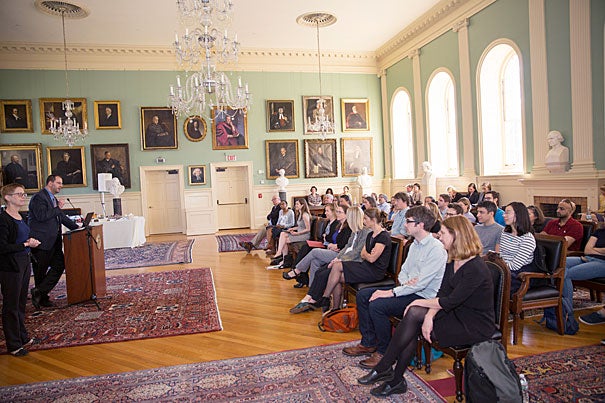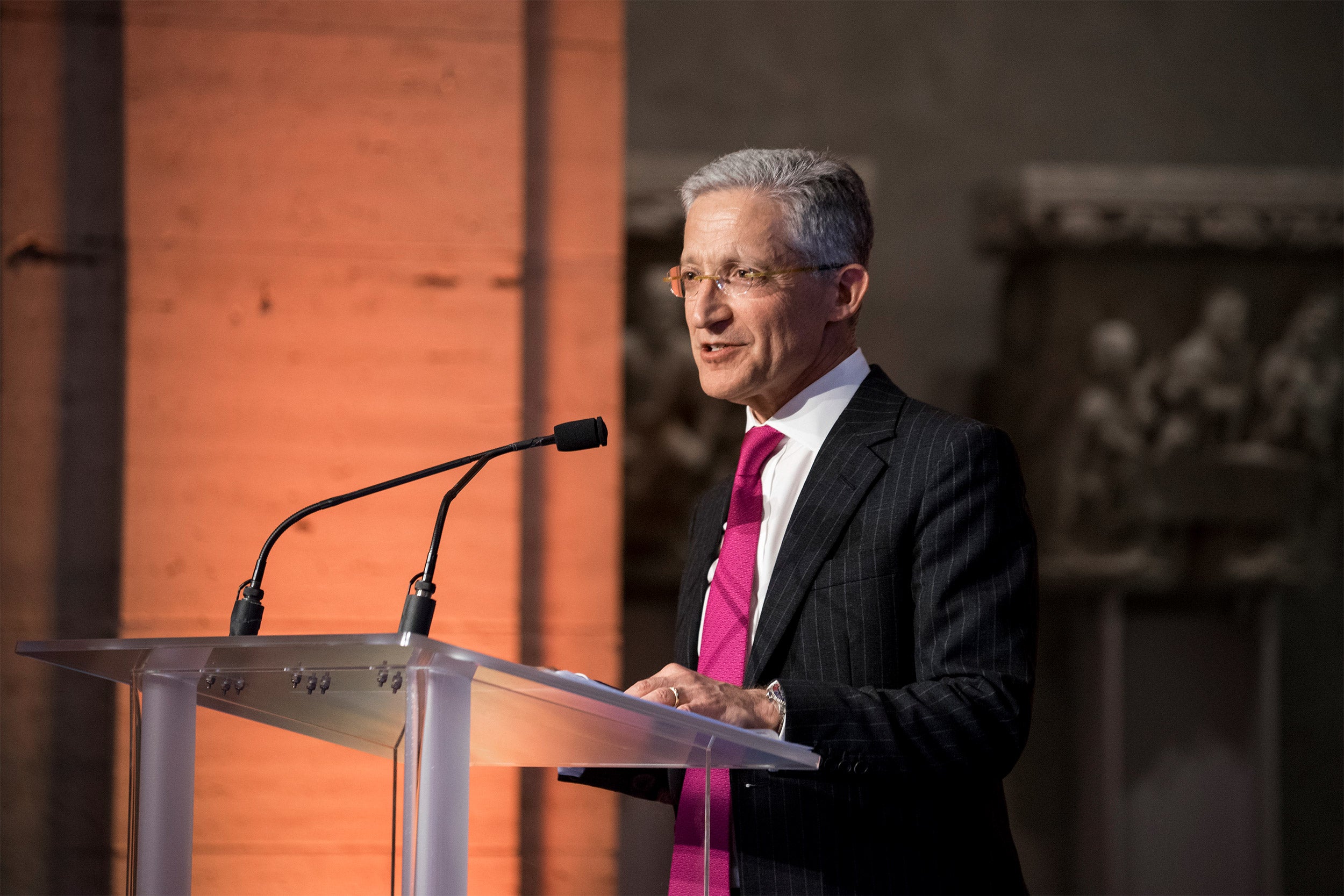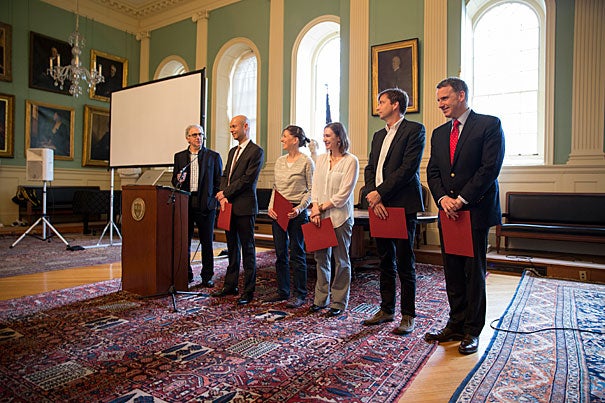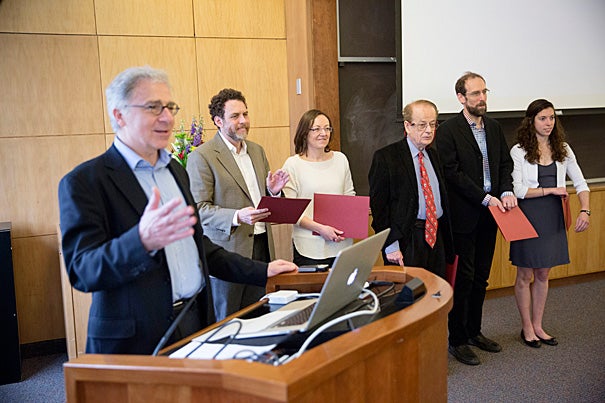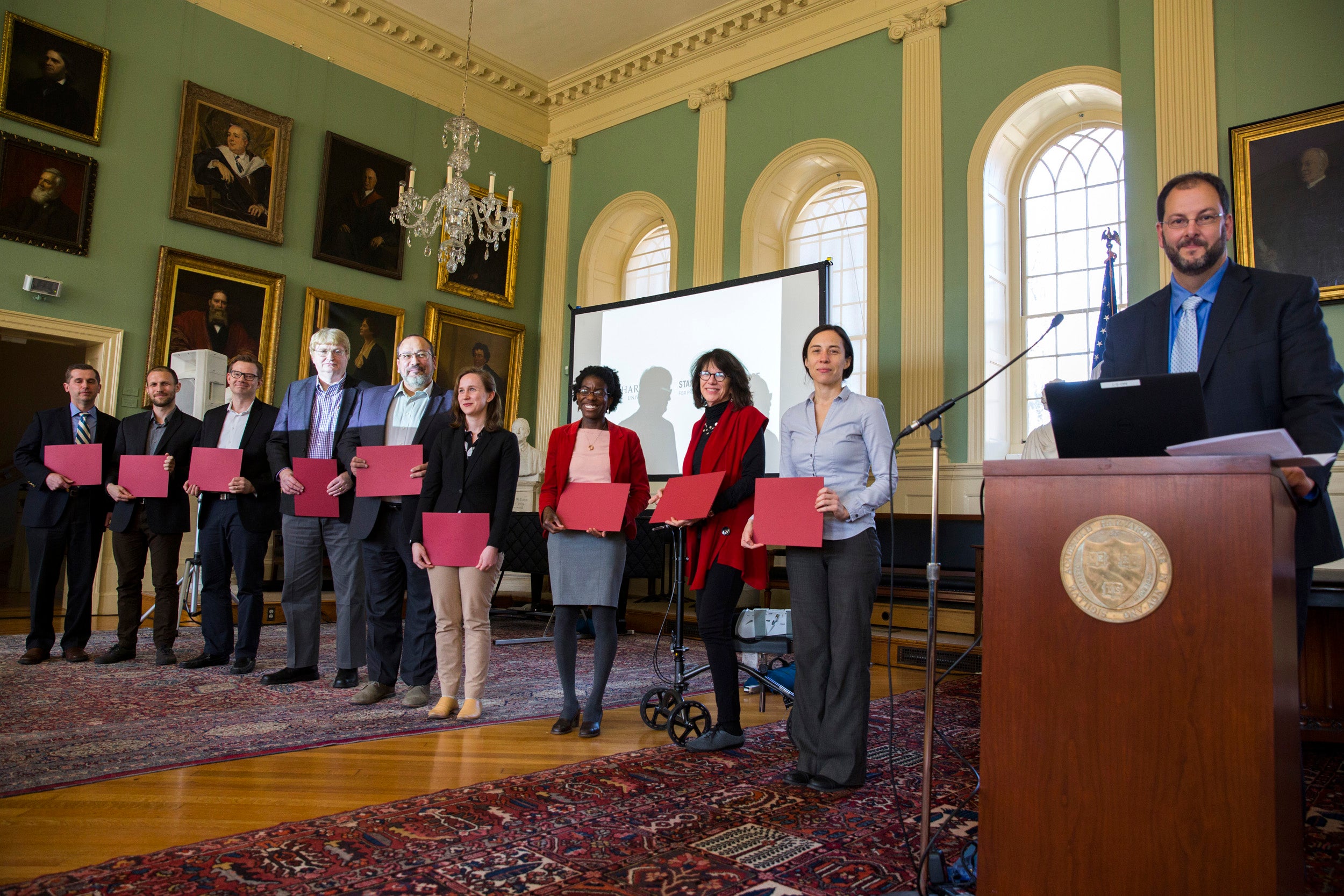
Faculty members who received grants from the Star Family Challenge —created through a gift from James A. Star ’83 to fund research unlikely to be funded through other programs — stand with Randy Buckner (right), chairman of the faculty review committee that selects the projects
Stephanie Mitchell/Harvard Staff Photographer
Rewarding remarkable studies
Star Family Challenge for Promising Scientific Research funds five high-risk, high-reward projects
It’s been said that scientists see the world differently than most people.
For the faculty selected to receive funding through the Star Family Challenge for Promising Scientific Research, sharing their vision means finding ways to make the invisible visible, from the physics of the early universe to the microbes that surround us to the telltale signs of an asteroid strike that changed Earth’s climate.
More like this
Created by a gift from James A. Star ’83, the annual Challenge funds high-risk, high-reward research that is unlikely to be funded through other programs — creative pursuits with the potential to contribute to radical new understandings of the world.
“The Challenge sits at the center of who we are as a scientific community,” said Randy Buckner, professor of psychology and neuroscience and chairman of the faculty review committee that selects the projects. “As a scientific community we aspire to take risks … What is needed to achieve those aspirations is often simply the means to begin.”
“The Star Family Challenge provides innovative projects and new collaborations the chance to test if their ideas are going to work at the very beginning,” he said. “The Challenge is important for the specific projects it is able to fund, but also because it tells the community what we stand for. We value innovation. They highlight that we take risks, and when we cross traditional boundaries the discoveries in one field can have a dramatic impact and change the course of other fields.”
Importantly, next year the Challenge’s ability to fund such projects will expand.
James A. Star ’83 (center), whose gift makes the Challenge possible, speaks with Doug Melton following the presentations.
Stephanie Mitchell/Harvard Staff Photographer
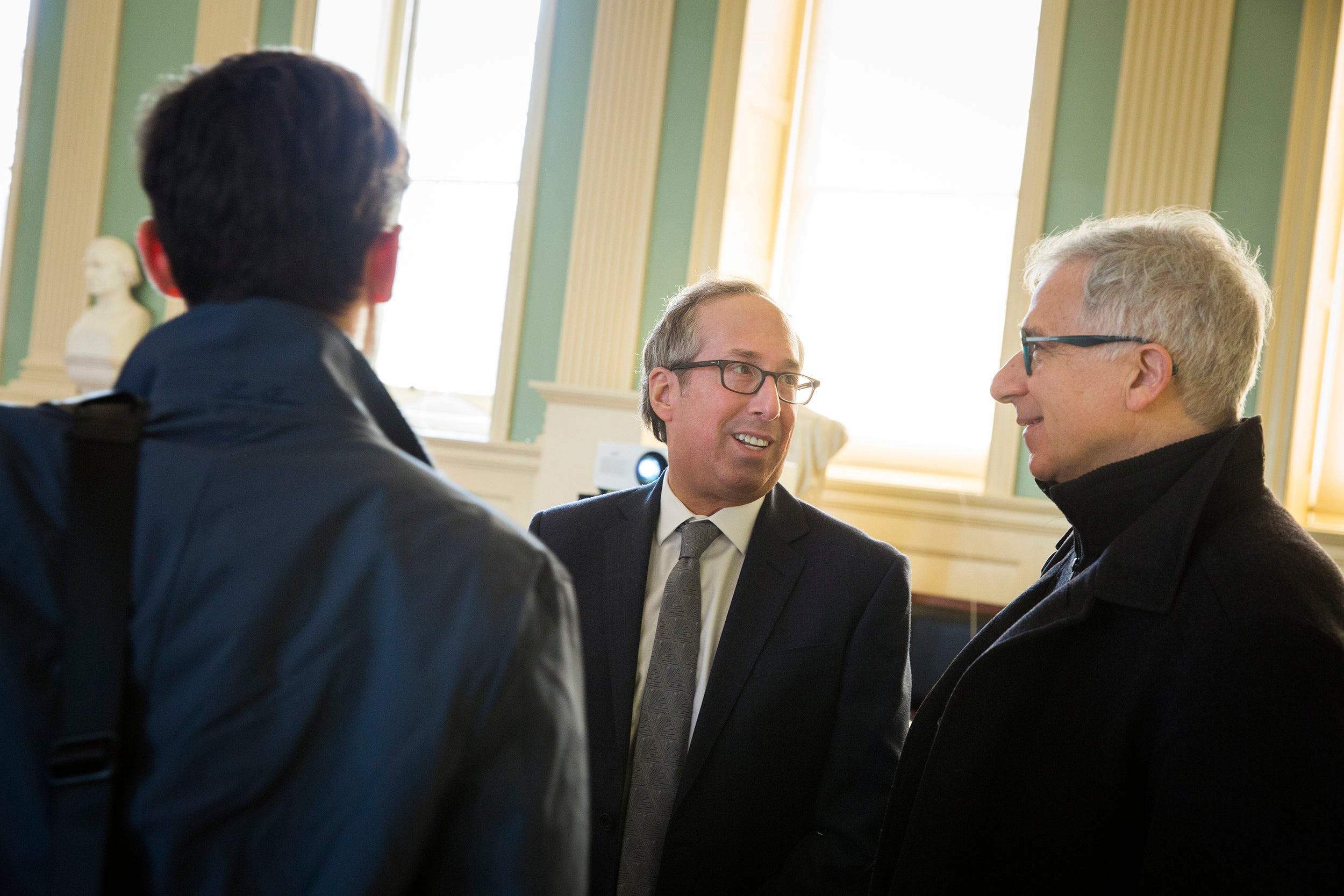
With support from Josh Friedman ’76, M.B.A. ’80, J.D. ’82, and Beth Friedman, the Challenge will double in size and expand to include faculty at both Harvard Medical School and the Harvard T.H. Chan School of Public Health. The expanded program will also get a change to its name, becoming the Star-Friedman Challenge for Promising Scientific Research.
More like this
As part of this year’s program, the researchers selected for awards — Cora Dvorkin; Karine Gibbs, and Colleen Cavanaugh; Peter Girguis and Aspen Reese; Stein Jacobsen; and Matthew Nock, Samuel Gershman, and J.P. Onnela — made short presentations about their work to a crowd in the Faculty Room of University Hall.
Here’s what they’re working on.
Cora Dvorkin
A fraction of a second after the Big Bang, the universe underwent a period of exponential expansion — known as inflation — that produced gravitational waves. Those waves left telltale signatures in the polarization of the cosmic microwave background, or CMB, a radiation that permeates all of space.
If researchers can “read” those patterns, said Dvorkin, assistant professor of physics, it would offer an important window into the physics of the early universe.
“About 380,000 years after the Big Bang, protons and electrons combined to form hydrogen, in a process known as recombination,” Dvorkin said. “Today, we detect the photons (that travel towards us freely since then) at microwave frequencies. What we measure in the sky with telescopes all over the world and satellites in space is the temperature fluctuations of photons in different positions. By assessing the statistical properties of these fluctuations, we can infer the physics from the very early universe.”
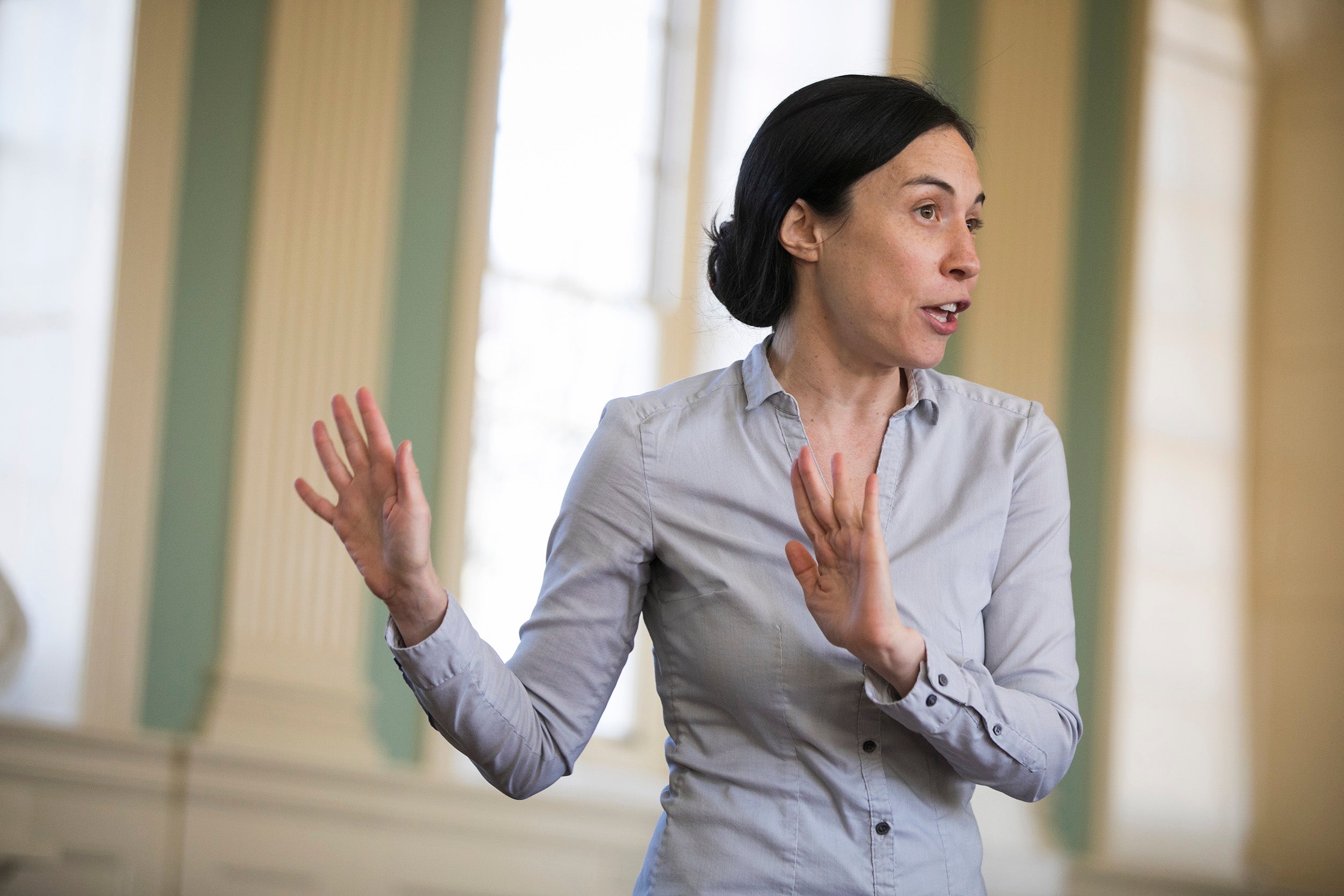
Making sense of the polarization patterns of the CMB, however, is easier said than done. Foreground contamination from our own galaxy makes it difficult to isolate background signals.
“How do we know if a measurement is primordial?” Dvorkin asked. “We have a potential sign coming from gravitational waves, but we have these galactic foregrounds … which have a signal that is very similar to the signal we are expecting to see.”
While researchers have made progress filtering out those foreground elements by using complex statistical methods, Dvorkin, undergraduates Sebastian Wagner-Carena ’18 and Max Hopkins ’18, and graduate student Ana Diaz Rivero hope to use newly developed learning algorithms to improve the process.
“A detection of primordial gravitational waves would constitute our most direct probe of the energy scale of the very early universe, and would transform our understanding of fundamental physics,” Dvorkin said. “In addition, it would tell us something about the quantum nature of gravity, since the signal is originated in the quantum fluctuations of space time.
“It would also give us a unique window into the highest energy we have ever probed … we could be measuring energies at the level of the grand unified theory model, or 1012 times higher than those probed at the Large Hadron Collider.”
Karine Gibbs and Colleen Cavanaugh
“When you think of microbes, you can think of them as being divided into three groups,” Gibbs, associate professor of molecular and cellular biology, told the audience. “There are things that are found in the environment, in the soil, or on plants. You can think of microbes as being commensal — organisms that are found in or around us. But when we think of microbes, we also often think of virulence. If you have ever had food poisoning, that is the result of a foreign microbe coming into your gut and taking over.”
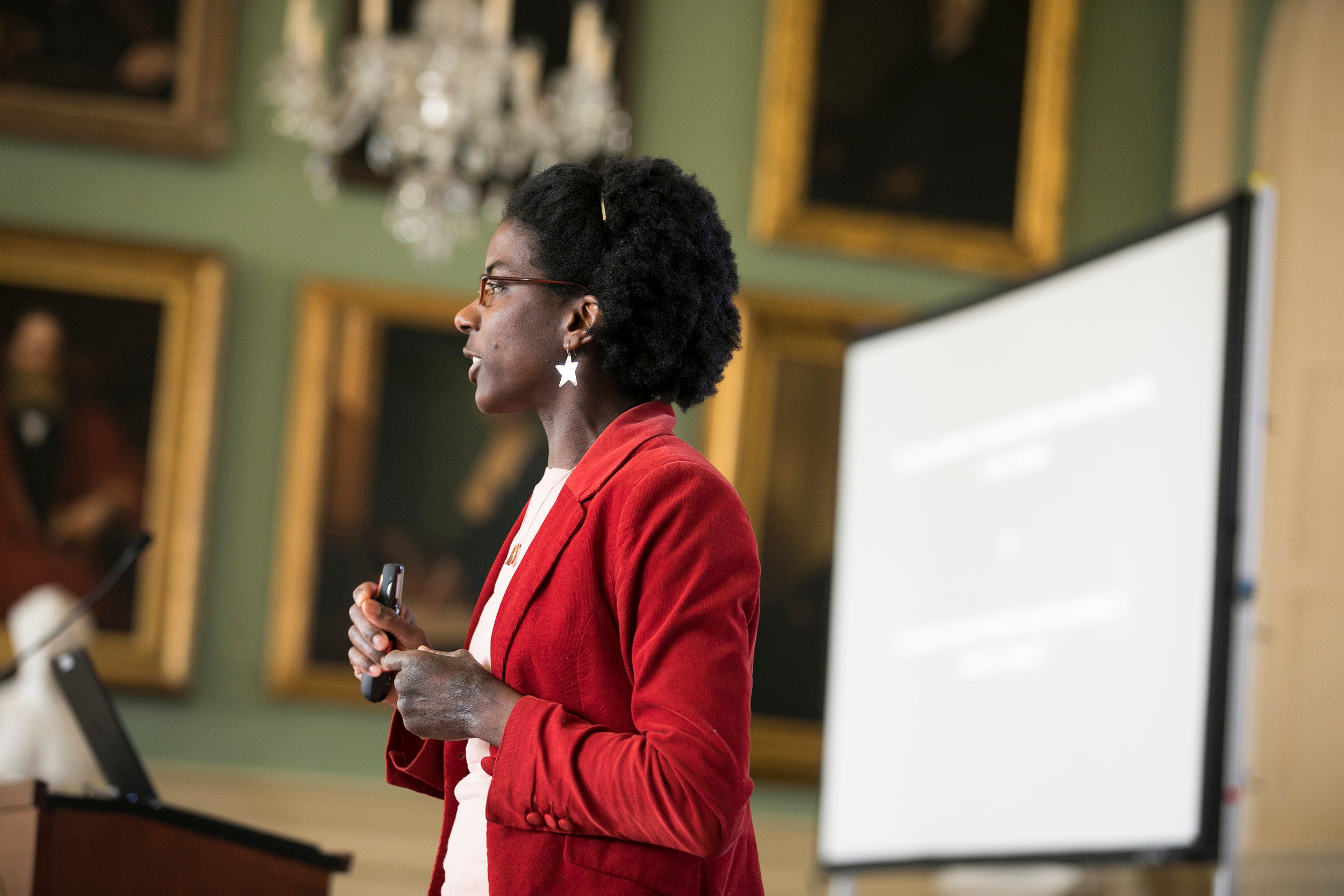
While it is tempting to think that the solution would be simply to identify all the microbes with the potential for causing illness, Gibbs said the uncomfortable truth is that there is evidence that, for some microbes, every strain may have the potential for virulence.
To explore that question, she and Cavanaugh, the Edward C. Jeffrey Professor of Biology, plan to study a common microbe found in the gut, Proteus mirabilis. While typically harmless, the microbe can become virulent and cause a variety of infections.
“This is a great model, we believe, to test this hypothesis,” Gibbs said. “The goal is to ask, for commensal bacteria … are only some strains in some people virulent, or is the case that any strain at any time can become virulent?”
To get at that question, they will combine expertise from Gibbs’ lab with research from Cavanaugh’s lab to look at how bacteria interact.
“Using deep genomic sequencing, the isolation of single strains, sequencing of whole genomes, and characterization of phenotypes, we want to ask specific questions,” Gibbs said. “In a healthy person, which bacteria are usually present? When you look at an infected person, do you see different strains, and are there characteristics of these human-associated pathogenic strains that are different?”
Peter Girguis and Aspen Reese
It’s natural to be concerned about the potential impact of microbes on human health. But Professor of Organismic and Evolutionary Biology Girguis told audience members that, on balance, we needn’t be.
“The good news is the vast majority of microbes in our biosphere are doing good things for us,” he said. “They produce half the oxygen you breathe, and they fix nitrogen, making it available for living organisms to use. Microbes are the stewards of our Earth … Without them, our biosphere would come to a halt.”
Yet despite the importance of microbes, Girguis said researchers know frustratingly little about many of them. Most cannot be cultured in the lab, and in many cases relatively little is understood about their metabolism.
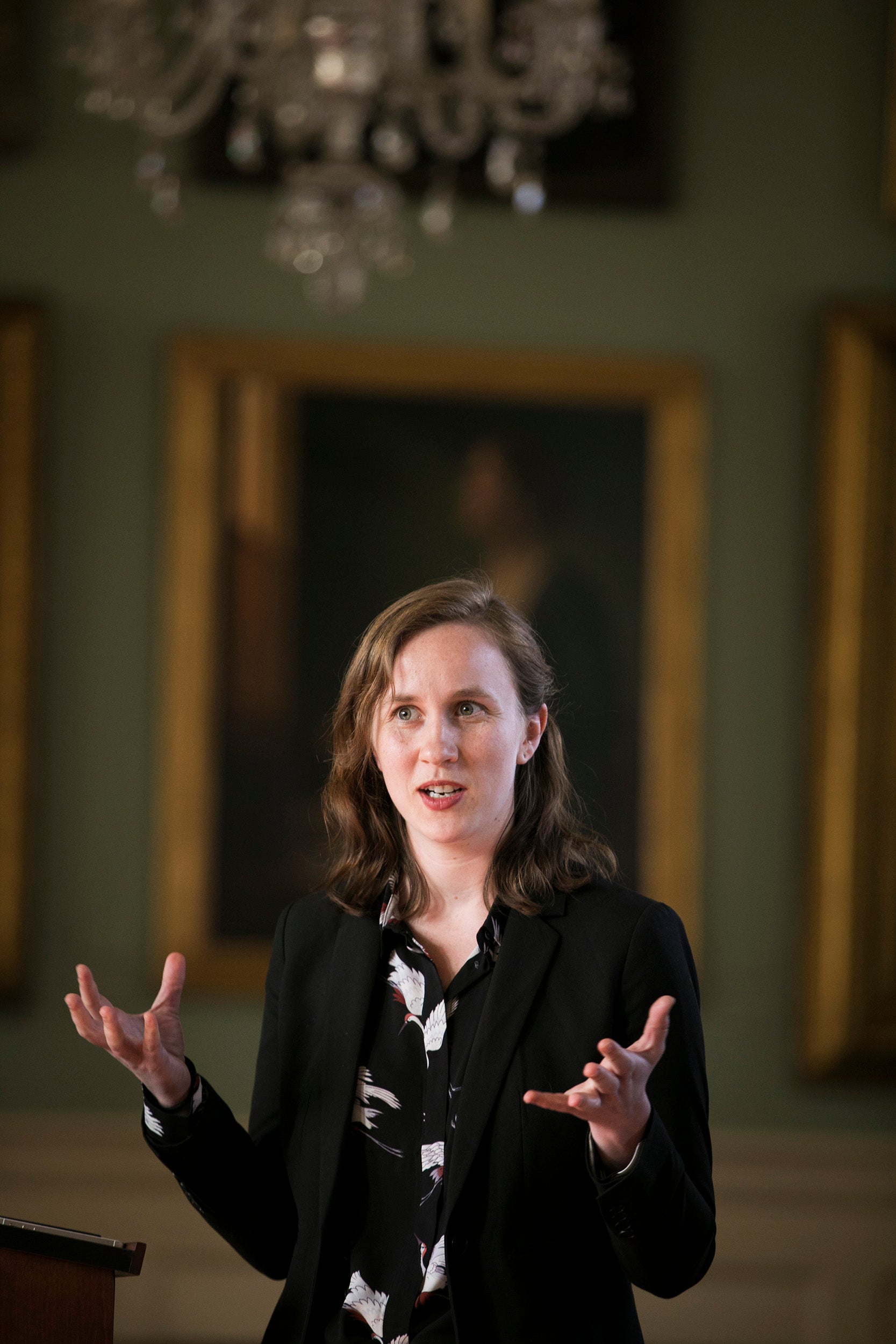
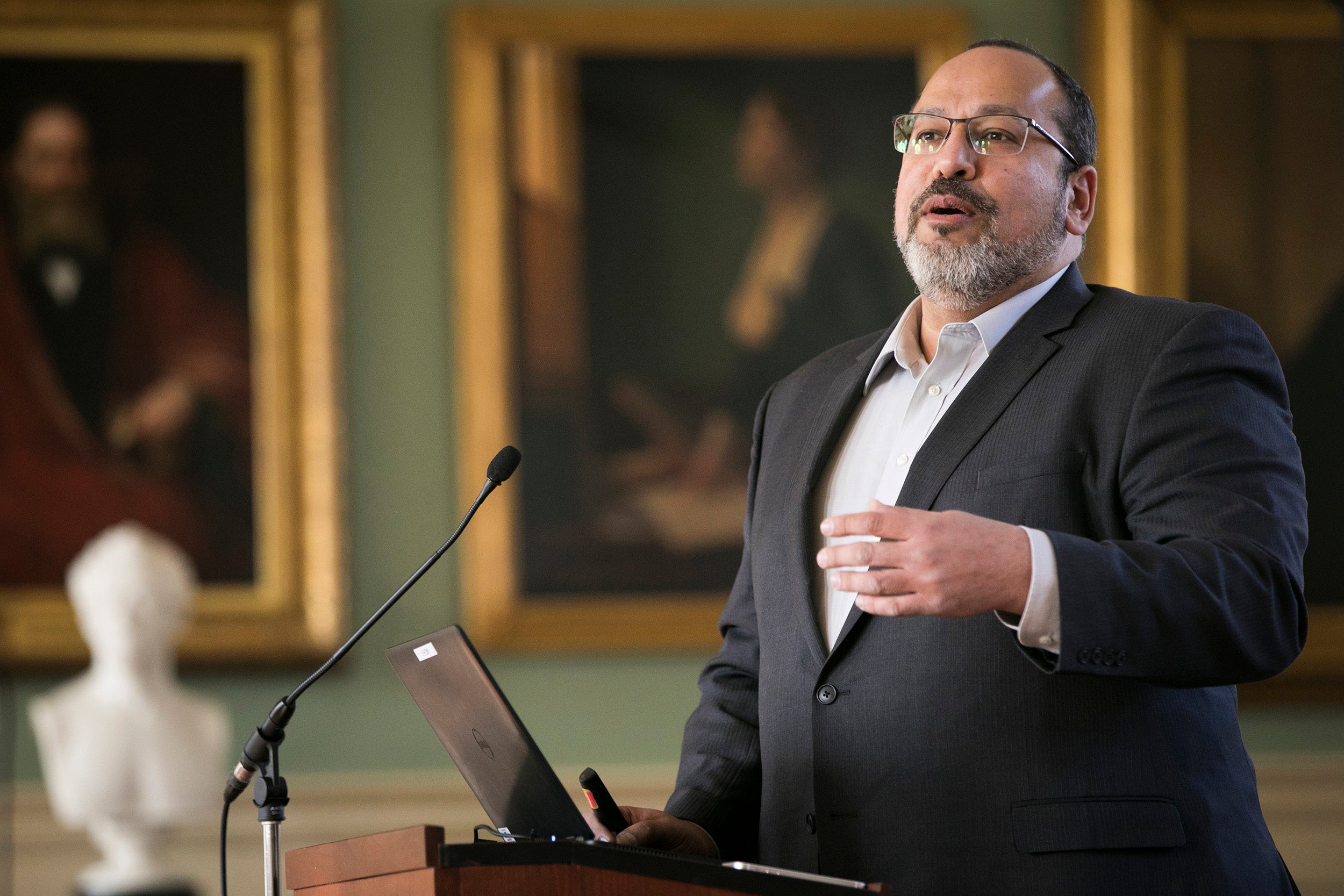
Aspen Reese and Peter Girguis present their project on collecting and protecting microbiomes. “For the first time, we’re going to be able to see what microbiomes looked like before 1990, when we started actually doing sequencing analyses,” Reese said.
Stephanie Mitchell/Harvard Staff Photographer
While technologies such as high-throughput sequencing have made it possible to study closely the microbes living today, Girguis said there is still a great deal to be learned by studying microbial populations of the past. To find them, he and Aspen Reese plan to turn to Harvard’s Museum of Comparative Zoology and its thousands of samples — some more than a century old — preserved in formaldehyde and ethanol.
The Challenge, said Reese, a junior fellow in the Society of Fellows, is that these “wet” specimens were prepared with an eye toward preserving morphology, not genetic material, “which is a problem because we need to get DNA to identify which microbes are present.”
Using techniques developed to “unfold” proteins, Reese and Girguis plan to extract DNA from specimens stored at Harvard and the Smithsonian National Museum of Natural History in Washington, D.C., and analyze their genetic sequences to see how microbiota may have changed over the last 100-plus years.
“For the first time, we’re going to be able to see what microbiomes looked like before 1990, when we started actually doing sequencing analyses,” Reese said. “Secondly, we want to start asking what we can do with museums to help us learn about microbiomes in the future — can we change the way museums take in animal specimens to allow us to ask better questions in the future about how these communities are actually changing over time?”
Stein Jacobsen
The end of the last Ice Age marked the start of a millennia-long warming trend on Earth, but approximately 12,000 years ago the process mysteriously reversed, with the planet suddenly returning to near-glacial conditions for more than 1,000 years. Known as the Younger Dryas period, the era is associated with the extinction of creatures like mammoths and mastodons, as well as the end of the Clovis culture, believed to be the first human civilization in North America.
What’s not known about the period, said Professor of Geochemistry Jacobsen, is whether the sudden cooling was part of the global climate cycle or was caused by a natural disaster, like an asteroid strike.
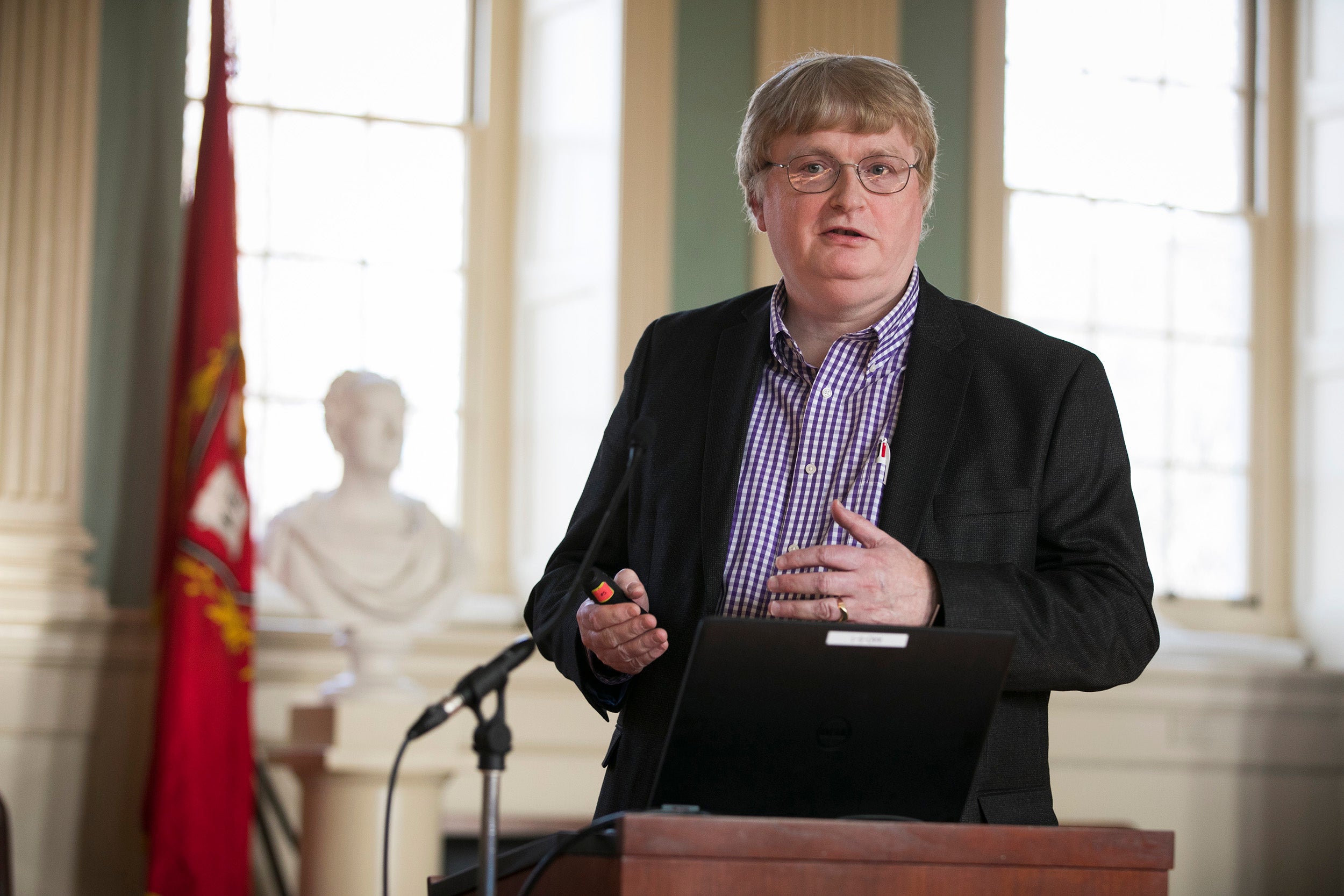
In an attempt to answer that question, Jacobsen examined ice cores collected in Greenland and uncovered an anomaly: Unusually high levels of platinum were trapped in the ice at the start of the Younger Dryas.
“Platinum concentrations are very low in crustal rock, but relatively high in meteorites,” he said. “There’s so little of it that all the platinum that has ever been mined would easily fit in this room. But what we want to know is whether this platinum anomaly is global.”
To do that, Jacobsen worked with other researchers to obtain new samples from Taylor Glacier in Antarctica, which he plans to test using a pair of new, more precise mass spectrometers.
“We are prepared to do a much better analysis than we were able to do before,” Jacobsen said. “The mass spectrometer we already have set up in the lab is more sensitive than the last instrument we used by a factor of about 30, and our other new instrument allows for very high prevision isotope ratio measurements.
More like this
“Our main result was the detection of this platinum anomaly in the Greenland ice cores, but the nature of it remains uncertain,” Jacobsen said. “Most likely it’s extraterrestrial … but the Antarctic samples will test whether these results are global.”
Matt Nock, Samuel Gershman, and J.P. Onnela
“Suicide has been around since the beginning of recorded history,” said Professor of Organismic and Evolutionary Biology Nock. “Since there has been history, humans have been perplexed by this problem, and we haven’t gotten very far.”
Despite decades of work to understand suicide and self-harm, Nock said, suicide remains the 10th leading cause of death in the U.S., and the second leading cause of death among people age 15‒34.
“Over the past 100 years, deaths from conditions like gastritis, pneumonia, tuberculosis, and even cancer, … as we make advances in science and medicine, we’ve seen these causes of death drop,” Nock said. “The same is not true for suicide. The rate is literally the same in 2017 as it was in 1917. We just haven’t made any noticeable progress.”
One reason for that, Nock said, is that most studies have the wrong focus.
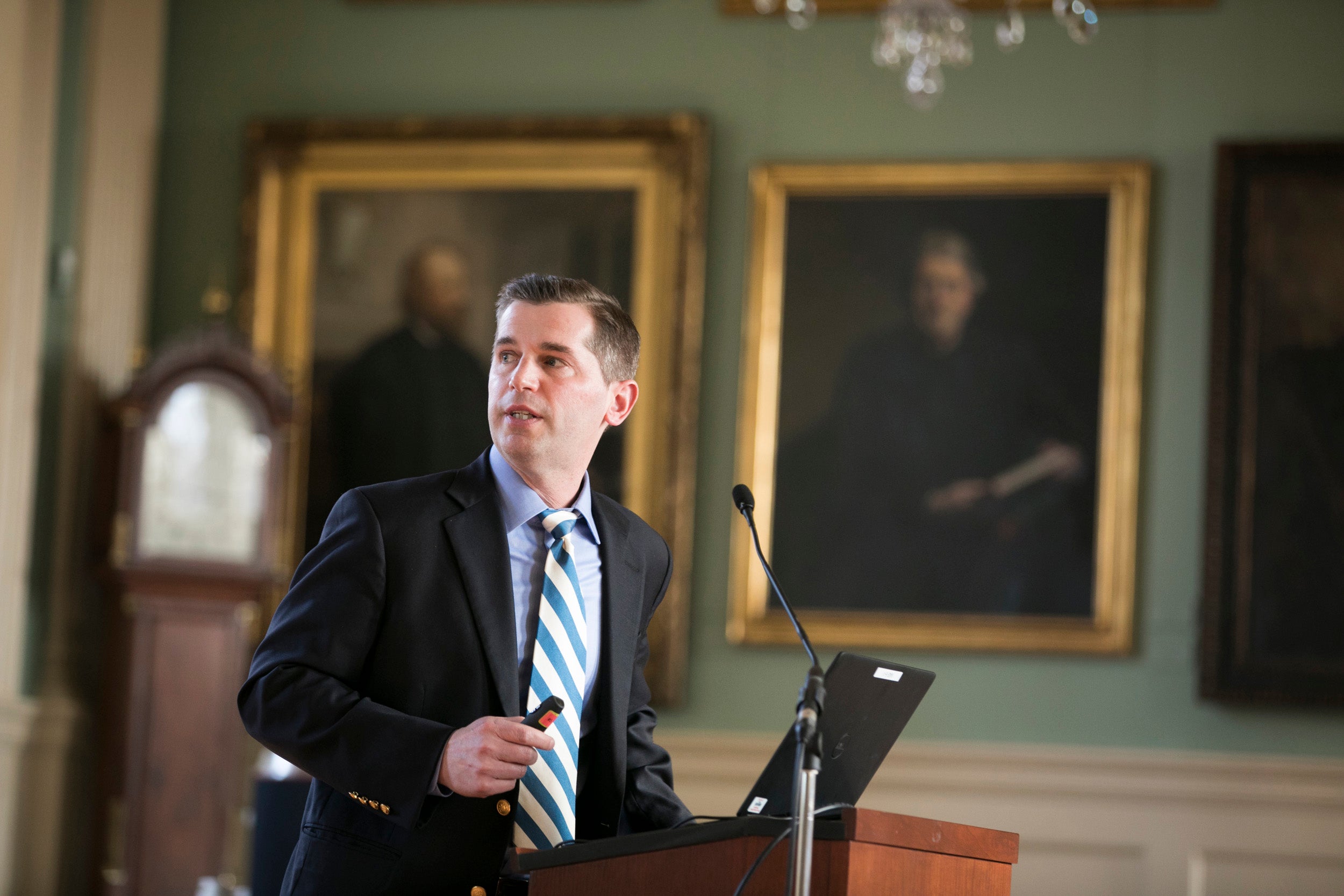
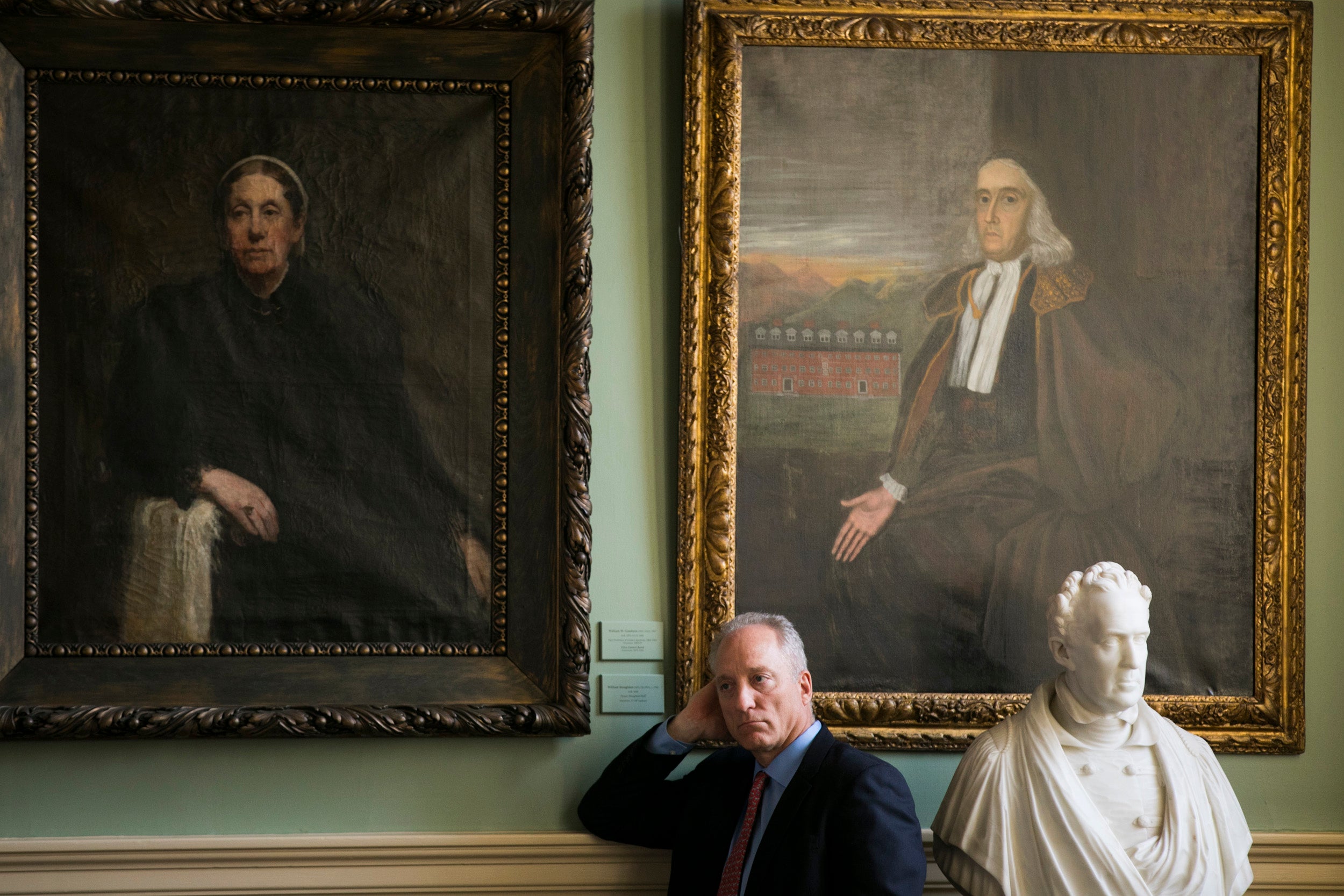
Matthew Nock presents his project with Samuel Gorshman and JP Onnela (not pictured) on using mobile passive monitoring, real-time assessments, and dynamic computational phenotypes to understand, predict, and prevent suicidal thoughts and behaviors. FAS Dean Michael Smith listens by the portraits lining the walls.
Stephanie Mitchell/Harvard Staff Photographer
Though research has shown that the risk of suicide skyrockets in the first month after discharge from hospitalization, Nock and colleagues showed that just 0.1 percent of all studies have centered on that timeframe.
“We now have the ability to get some real traction here … because, for better or worse, we have all become digital cyborgs,” Nock said. “We all have these digital appendages we’re walking around with that are collecting data on each of us.”
Using data collected from smartphone and wearable sensors, Nock said, researchers can develop “digital phenotypes [that] capture very fine-grained data … about how someone’s thoughts and feelings and behavior change when they move into a depressive episode or a manic episode or a suicidal episode.
More like this
“That allows us to test existing theories using ecologically valid data,” Nock said. “That can help move us toward the Holy Grail of being able to intervene before people become suicidal. If we get good enough at identifying people when they’re most at risk, we can then beam them interventions to their smartphone or social media that can drive down that risk.”
Nock, Assistant Professor Gershman of Harvard’s Center for Brain Science, and Onnela of the Harvard Chan School have developed a plan to use smartphone monitoring, wearable sensors, and real-time tests to measure suicidal thinking and collect massive amounts of data on 100 adolescents after their discharge from Franciscan Children’s Hospital in Brighton, Mass. The hope, Nock said, is that the pilot project might lead to future funding for larger, similar efforts.
“Our goal here is to use this information to provide a much richer digital and computational phenotype of … what happens during suicidal thoughts and behaviors,” he said. “The upside here if we succeed is potentially huge. This will not only give us a better understanding of what suicidal episodes look like for the first time, it will also help us improve our ability to predict when people’s suicidal thoughts may worsen and when people may actually engage in suicide attempts … and hopefully decrease the loss of life due to suicide.”



